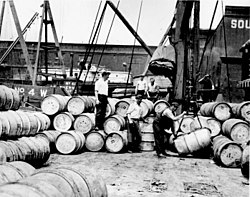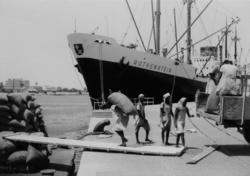Etymology
The word stevedore () originated in Portugal or Spain, and entered the English language through its use by sailors. [3] It started as a phonetic spelling of estivador (Portuguese) or estibador (Spanish), meaning a man who loads ships and stows cargo, which was the original meaning of stevedore (though there is a secondary meaning of "a man who stuffs" in Spanish); compare Latin stīpāre meaning to stuff, as in to fill with stuffing. In Ancient and Modern Greek, the verb στοιβάζω (stivazo) means pile up. [4] [5] In Great Britain and Ireland, people who load and unload ships are usually called dockers; in Australia, they are called stevedores, dockworkers or wharfies; and, in the United States and Canada, the term longshoreman, derived from man-along-the-shore (or alongshore + man), is used. [6] [7] Before the extensive use of container ships and shore-based handling machinery in the United States, longshoremen referred exclusively to the dockworkers, while stevedores, part of a separate trade union, worked on the ships operating their cranes and moving cargo.
Loading and unloading ships
Loading and unloading ships requires knowledge of the operation of loading equipment, the proper techniques for lifting and stowing cargo, and the correct handling of hazardous materials. In addition, workers must be physically strong and able to follow orders attentively. Many longshoremen are needed to unload a ship. A ship can only be at a port for a limited amount of time, so their work must be completed quickly.
In earlier days before the introduction of containerization, men who loaded and unloaded ships had to tie down cargoes with rope. A type of stopper knot is called the stevedore knot. Securely tying up parcels of goods is called stevedore lashing or stevedore knotting. While loading a general cargo vessel, they use dunnage, which are pieces of wood (or nowadays sometimes strong inflatable dunnage bags) set down to keep the cargo out of any water that might be lying in the hold or are placed as shims between cargo crates for load securing.
Today, the vast majority of non-bulk cargo is transported in intermodal containers. [17] The containers arrive at a port by truck, rail, or another ship and are stacked in the port's storage area. When the vessel that will be transporting them arrives, the containers it is offloading are unloaded by a crane. The containers either leave the port by truck or rail or are stored until they are placed on another ship. Once the ship is offloaded, the containers it leaves with are brought to the dock by truck. A crane lifts the containers from the trucks onto the ship. As the containers pile up on the ship, the workers connect them to the vessel and the other already-placed containers. The jobs involved include the crane operators, the workers who connect the containers to the ship and each other, the truck drivers who transport the containers from the dock and storage area, the workers who track the containers in the storage area as they are loaded and unloaded, as well as various supervisors. Those workers at the port who handle and move the containers are likely to be considered stevedores or dockworkers.
Before containerization, freight was often handled with a longshoreman’s hook, a tool which became emblematic of the profession (mainly on the west coast of the United States and Canada). [18]
Traditionally, stevedores had no fixed job but would arrive at the docks in the morning seeking employment for the day. London dockers called this practice standing on the stones, [19] while in the United States, it was referred to as shaping up or assembling for the shape-up. [20] [21]
Dock workers have been a prominent part of the modern labor movement. [22]
- Container handling in Hong Kong – 2005
At anchor, two
barges with cranes (floating derricks) at port
A container is lifted from the deck.
Dockworkers on the containers in the ship's hatch
Strong tidal current, loading work in adverse conditions
This page is based on this
Wikipedia article Text is available under the
CC BY-SA 4.0 license; additional terms may apply.
Images, videos and audio are available under their respective licenses.





